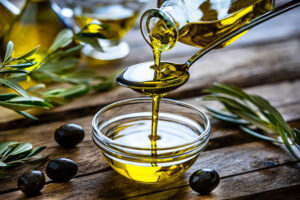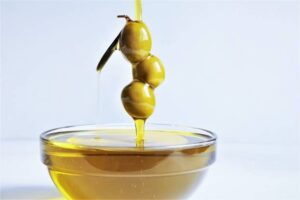
5 Types of olive oils and how to use them for healthy cooking
Types of olive oils and how to use them When it comes to choosing the best olive oil for cooking, there are several factors to consider, including the type of cooking you plan to do and your personal preferences. Here are some common types of olive oil and their recommended uses:
1. Extra Virgin Olive Oil (EVOO):

- Extra Virgin Olive Oil (EVOO) is widely regarded as the highest quality and most flavorful olive oil. Here are some key characteristics and uses-
- Production Process: EVOO is made from the first cold pressing of olives, meaning the oil is mechanically extracted without the use of heat or chemicals. This gentle extraction process helps retain the oil’s natural flavours and nutrients.
- Flavor Profile: EVOO has a rich, robust flavour with fruity, grassy, and sometimes peppery notes. The specific flavour profile can vary depending on the variety of olives used and their growing conditions.
- Acidity Level: EVOO has the lowest acidity level (typically below 0.8%) among all olive oils, which is a key indicator of its quality. Low acidity levels are a result of the high-quality olives used and the careful production process.
- Health Benefits: EVOO is well-known for its health benefits. It’s rich in monounsaturated fats, antioxidants (such as vitamin E and polyphenols), and anti-inflammatory compounds. Regular consumption of EVOO has been linked to a reduced risk of heart disease, improved cholesterol levels, and various other health advantages.
- Cooking Uses: EVOO is best suited for low to medium-heat cooking, such as sautéing, searing, roasting, and baking. Its lower smoke point (typically around 375°F or 190°C) means it may not be suitable for very high-heat cooking methods like deep frying, where oils with higher smoke points are preferred.
- Finishing Oil: EVOO shines when used as a finishing oil. Drizzle it over salads, grilled vegetables, pasta, or fresh bread to enhance the flavour of your dishes. Its rich taste and aroma make it a favourite for dressings and dipping.
- Storage: To preserve the quality of EVOO, store it in a cool, dark place, away from direct sunlight and heat. Proper storage helps prevent oxidation, which can degrade the oil’s flavour and nutritional value over time.
- When choosing EVOO, look for reputable brands and check the label for information about the olive variety, region of origin, and the harvest date. The fresher the oil, the more vibrant and complex its flavour will be. EVOO is an excellent choice for those who appreciate the distinctive taste of olives and want to enjoy the health benefits it offers.
2. Virgin Olive Oil:

- Virgin Olive Oil: Virgin olive oil is another type of olive oil that is less processed than regular or pure olive oil but not as unrefined as extra virgin olive oil. Here are some key characteristics and uses:
- Production Process: Like extra virgin olive oil, virgin olive oil is also made from the first pressing of olives without the use of heat or chemicals. However, it may have slightly higher acidity levels (typically up to 2%) compared to extra virgin olive oil.
- Flavor Profile: Virgin olive oil has a milder and more neutral flavour compared to extra virgin olive oil. While it still retains some fruity and grassy notes, it lacks the intense and complex flavour of EVOO.
- Acidity Level: Virgin olive oil has a slightly higher acidity level compared to extra virgin olive oil but is still considered a good-quality oil. The slightly higher acidity may result from using olives that are not as perfectly ripe or from less stringent production processes.
- Cooking Uses: Virgin olive oil is a versatile cooking oil that can be used for a variety of cooking methods, including sautéing, grilling, roasting, and baking. Its moderate smoke point (typically around 375°F or 190°C) makes it suitable for most culinary applications.
- Health Benefits: Virgin olive oil, like extra virgin olive oil, contains monounsaturated fats and antioxidants. While it may have slightly fewer antioxidants and health benefits compared to EVOO due to the differences in production and quality, it is still a healthier choice compared to many other cooking oils.
- Affordability: Virgin olive oil is often more affordable than extra virgin olive oil, making it a cost-effective choice for everyday cooking.
- When selecting virgin olive oil, it’s essential to look for reputable brands that provide information about the olive variety and origin. While it may not have the intense flavour of extra virgin olive oil, virgin olive oil is a good all-purpose cooking oil that offers many of the health benefits associated with olive oil consumption. It’s a versatile choice for home cooks looking for a balance between flavour and affordability in their cooking oil.
3. Pure Olive Oil:-

- Pure Olive Oil: Also known as “Olive Oil” or “Pure Olive Oil,” this type of olive oil is a blend of both virgin olive oil and refined olive oil. It is a more processed and milder-tasting option compared to extra virgin and virgin olive oils. Here are some key characteristics and uses:
- Production Process: Pure olive oil is made by blending virgin olive oil (usually of lower quality or with higher acidity) with refined olive oil. The refining process involves using heat and chemical treatments to neutralize undesirable flavours and reduce acidity. This results in a milder, more neutral-tasting oil.
- Flavor Profile: Pure olive oil has a very mild and neutral flavour compared to extra virgin and virgin olive oils. It lacks the distinctive fruity or grassy notes found in these higher-quality olive oils.
- Acidity Level: Pure olive oil typically has higher acidity levels than extra virgin and virgin olive oils, usually between 1-3%.
- Cooking Uses: Due to its higher smoke point (usually around 410°F or 210°C), pure olive oil is suitable for a wide range of cooking methods, including frying, sautéing, grilling, and roasting. It is a good choice for high-heat cooking where the more delicate flavours of extra virgin or virgin olive oil might be lost.
- Health Benefits: While pure olive oil still contains some monounsaturated fats and healthful compounds, it may have fewer antioxidants and health benefits compared to extra virgin or virgin olive oil because of the refining process. Nevertheless, it remains a healthier option compared to many other cooking oils.
- Affordability: Pure olive oil is often more affordable than extra virgin or virgin olive oil, making it a practical choice for everyday cooking.
- Pure olive oil is commonly used in Mediterranean countries for general cooking purposes. It offers the health benefits associated with olive oil consumption, such as being heart-healthy due to its monounsaturated fats, while being versatile in the kitchen due to its higher smoke point. If you’re looking for a cooking oil that strikes a balance between affordability and health benefits, pure olive oil can be a suitable choice. However, for dishes where you want to emphasize the flavour of olive oil, extra virgin or virgin olive oil may be preferred.
4. Light Olive Oil:-

- Light olive oil is often misunderstood due to its name. Contrary to what the name suggests, “light” in this context doesn’t refer to a reduced calorie content or a healthier option. Instead, it denotes a milder flavour and a higher smoke point compared to extra virgin and virgin olive oils. Here are some key characteristics and uses:
- Production Process: Light olive oil is a heavily processed olive oil. It is typically made from a blend of virgin and refined olive oils. The refining process involves using heat and chemical treatments to remove impurities, neutralize undesirable flavours, and increase the oil’s smoke point.
- Flavor Profile: Light olive oil has an extremely mild and neutral flavour. It lacks the fruity and grassy notes of extra virgin and virgin olive oils and doesn’t contribute a strong olive flavour to dishes.
- Acidity Level: Light olive oil usually has higher acidity levels (around 3-4%) compared to extra virgin and virgin olive oils.
- Cooking Uses: Light olive oil has a higher smoke point, typically around 410°F or 210°C, which makes it suitable for high-heat cooking methods like frying, grilling, and baking. It is often used when you want the benefits of olive oil without the strong flavour.
- Health Considerations: While light olive oil still contains some monounsaturated fats and healthful compounds, it may have fewer antioxidants and health benefits compared to extra virgin or virgin olive oil due to the refining process.
- It’s important to note that light olive oil is not necessarily a “diet” or “low-calorie” version of olive oil. It simply has a milder flavour and a higher smoke point, making it suitable for cooking methods where the distinctive flavour of olive oil is not desired.
- When choosing light olive oil, be aware of its intended use. If you’re looking for an olive oil to use for high-heat cooking or when you don’t want the olive oil flavour to dominate your dishes, light olive oil can be a practical choice. However, for dishes where you want the characteristic olive oil taste, extra virgin or virgin olive oil is a better option. Always check the label for information on the production process and quality to ensure you’re getting a product that suits your culinary needs.
5. Olive pomace oil
- Olive pomace oil is a type of olive oil extracted from the pomace, which is the leftover olive paste after the initial pressing and extraction of extra virgin and virgin olive oils. It is the most processed and least expensive among olive oils. Here are some key characteristics and uses:
- Production Process: Olive pomace oil is extracted using solvents and heat to extract the remaining oil from the pomace. This process is called solvent extraction. The resulting oil is then refined to remove any impurities and undesirable flavours. As a result, olive pomace oil has a very neutral flavour.
- Flavor Profile: Olive pomace oil has an extremely mild and neutral flavour. It lacks the distinctive olive flavour found in extra virgin and virgin olive oils.
- Acidity Level: Olive pomace oil typically has higher acidity levels compared to extra virgin and virgin olive oils due to the extraction and refining processes.
- Cooking Uses: Olive pomace oil has a higher smoke point than extra virgin, virgin, and even light olive oil, typically around 460°F (240°C). This makes it suitable for high-heat cooking methods such as deep frying, stir-frying, and grilling. It is often used in commercial frying operations due to its affordability and high smoke point.
- Health Considerations: While olive pomace oil still contains some monounsaturated fats and healthful compounds, it may have fewer antioxidants and health benefits compared to extra virgin or virgin olive oil due to the extensive processing.
- Olive pomace oil is primarily used in situations where a very mild-flavoured, heat-resistant oil is required. It is often chosen for frying because it can withstand high temperatures without breaking down and producing harmful compounds. However, it doesn’t carry the distinctive flavour and many of the health benefits associated with higher-quality olive oils.
If you’re looking for an economical and heat-tolerant cooking oil, olive pomace oil can be a practical choice. However, if you want to enjoy the flavour of olive oil in your dishes or benefit from its potential health advantages, consider using extra virgin or virgin olive oil for lower-heat cooking or as a finishing oil. Always check product labels for information on the production process and quality when selecting olive pomace oil.
Is using olive oil beneficial?

- Heart Health: Olive oil is rich in monounsaturated fats, particularly oleic acid, which is associated with several heart-healthy benefits. Consuming olive oil in place of saturated and trans fats can help reduce the risk of heart disease by improving cholesterol levels and reducing inflammation.
- Antioxidants: Olive oil contains antioxidants, such as vitamin E and polyphenols, which help combat oxidative stress and inflammation in the body. These antioxidants may contribute to its cardioprotective and anti-inflammatory effects.
- Weight Management: Despite being calorie-dense, olive oil, when used in moderation, can be part of a healthy weight management plan. The monounsaturated fats in olive oil can help increase feelings of fullness, potentially leading to reduced overall calorie intake.
- Cancer Prevention: Some studies suggest that the compounds found in olive oil may have a protective effect against certain types of cancer, including breast and colorectal cancer. The antioxidants and anti-inflammatory properties may play a role in this benefit.
- Digestive Health: Olive oil has been traditionally used to aid digestion and relieve constipation. It may help stimulate the digestive system and promote the absorption of nutrients.
- Skin and Hair Health: Olive oil is a common ingredient in skincare and hair care products due to its moisturizing and antioxidant properties. Applying olive oil topically can help keep the skin hydrated and protect against oxidative damage.
- Versatility in Cooking: Olive oil is a versatile cooking oil that can be used for various culinary purposes, from sautéing and roasting to salad dressings and dipping. Its distinct flavour adds depth to dishes, and its moderate smoke point makes it suitable for many cooking methods.
- While olive oil offers numerous health benefits, it’s essential to use it in moderation, as it is calorie-dense. One to two tablespoons per day as part of a balanced diet is generally considered a reasonable amount.
- When selecting olive oil, opt for high-quality options like extra virgin or virgin olive oil, as they retain more of the beneficial compounds and have a richer flavour. Store olive oil in a cool, dark place to prevent oxidation, which can degrade its quality over time.
- Overall, incorporating olive oil into your diet can be a healthy choice that contributes to your overall well-being, especially when used as a replacement for less healthy fats and oils in your cooking and food preparation.

